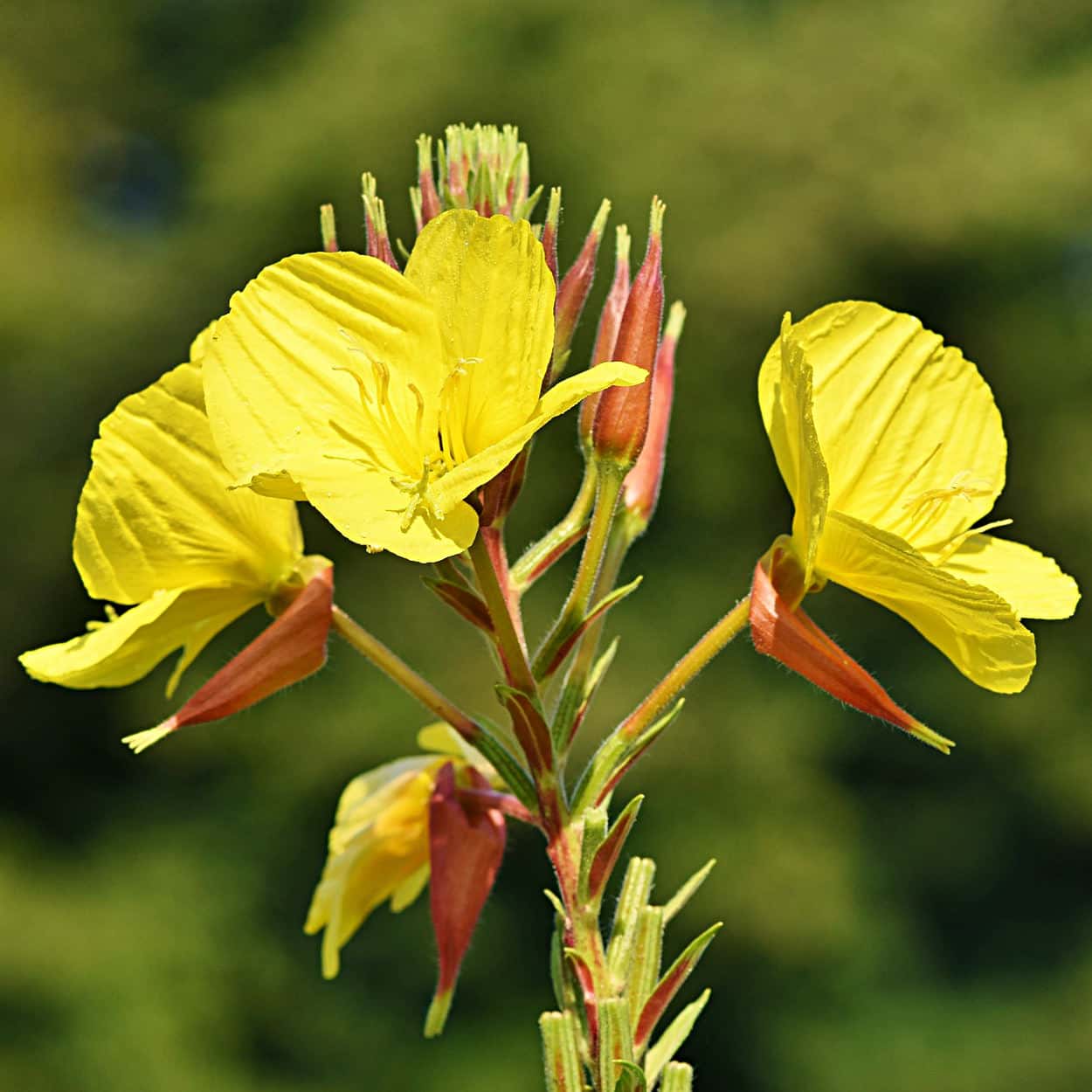
The evening primrose is native to North America, where it grows like a weed. Not really a primrose, it is sometimes called “sun drop.”
The large yellow flower opens late in the day and lasts only one evening, then produces lots of small seeds. Presumably, these seeds were carried to Europe early in the history of colonization of North America because evening primrose now grows wild in many parts of the continent.
Evening primrose to be used for herbal medicines is commercially cultivated and carefully bred to yield constant levels of the essential fatty acids in the seeds.
Growers in the United States and Canada alone produce three hundred to four hundred tons of seeds each year.
Oil from the seeds is the only part of the plant currently used, although pre-Columbian people used the entire plant for a variety of conditions.
Active Ingredients
Seeds of the evening primrose are rich in oil that has an unusual makeup of fatty acids.
Approximately 70 percent of the oil is cis-linoleic acid, and as much as 9 percent cis-gamma-linolenic acid (GLA). GLA is an essential intermediate step in the process our bodies use to manufacture prostaglandins.
Despite the fact that most over-the-counter pain relievers and many prescription arthritis medicines work primarily by blocking prostaglandin synthesis, prostaglandins do play an important role in many biochemical reactions. Very few plants contain GLA in any significant quantity.
The oil also contains campestrol and beta-sitosterol.
Uses
Some of the uses for which GLA is promoted are based on biochemical theory. Clinical trials have yielded mixed results in many cases, with the enthusiasm of initial success often fading before placebo-controlled trials.
The strongest evidence for efficacy is in the treatment of atopic dermatitis. In these conditions, the skin is itchy, red, scaly, dry, and inflamed.
Several double-blind, placebo-controlled studies have shown that oil of evening primrose can relieve these bothersome symptoms and reduce patients’ reliance on corticosteroid medicines (for example, hydrocortisone cream).
In a meta-analysis of nine studies, the herbal preparation was shown to be significantly better than placebo. In a few other double-blind studies, GLA from evening primrose had no advantage over placebo.
Another condition for which GLA might, in theory, be helpful is premenstrual syndrome. Early research demonstrated that the oil could reduce breast tenderness and cyclical mood swings.
A subsequent Australian study was not able to find that evening primrose oil offered any advantage over placebo treatment for this condition. A trial of GLA for hot flashes associated with menopause found it was no better than placebo.
Evening primrose oil is also said to help lower blood cholesterol levels.
In one placebo-controlled investigation, 4 g daily of Efamol brand evening primrose oil brought down total cholesterol by about 30 percent over the course of three months, while placebo-treated patients experienced a nonsignificant drop in cholesterol.
Other studies also showed Efamol can lower cholesterol and triglycerides and reduce platelet aggregation (a risk factor for blood clots that cause strokes and heart attacks).
Unfortunately, a trial utilizing a different brand of standardized evening primrose oil was unable to demonstrate any significant changes in total cholesterol, triglycerides, or HDL cholesterol.
Evening primrose oil, with and without fish oil, has been tested as a treatment for rheumatoid arthritis. More than three months of treatment with GLA are required to see any response in rheumatoid arthritis.
At least two placebo-controlled trials have shown benefits such as less morning stiffness or less reliance on arthritis pain medicines (NSAIDs).
Biochemical reasoning suggests that GLA plays a crucial role in the brain and nervous system, and evening primrose oil has been recommended as a supportive treatment in multiple sclerosis. Studies of its use for this serious condition have been small, however, and the results inconclusive.
In one study, evening primrose oil stabilized or reversed neurological damage in diabetic patients. If this activity can be confirmed, it would represent an important option in treating this difficult problem.
Evening primrose oil has been tested for a wide variety of other disorders, but in most instances the evidence is unconvincing or requires confirmation by way of placebo-controlled, double-blind studies.
As a result, it is not possible to say for sure whether GLA can be helpful for hyperactive children, people with alcohol-induced liver damage, or people with autoimmune diseases, Sjogren’s syndrome or chronic inflammation.
Dose
Evening primrose oil is available in 500-mg capsules. Most of the clinical trials have utilized doses of one or two capsules two or three times a day, with the maximum adult dose of 4 g daily.
Up to three months may be needed to see a response in some conditions.
Special Precautions
No special precautions are necessary.
Adverse Effects
There are no significant side effects reported, except as noted below.
Possible Interactions
Evening primrose oil, and by extension GLA, should not be consumed by schizophrenic patients taking phenothiazine drugs such as Compazine (prochlorperazine), Mellaril (thioridazine), Sparine (promazine), Stelazine (trifluoperazine), Thorazine (chlorpromazine), or Trilafon (perphenazine). The combination may increase the risk of epileptic seizure.
Other drugs, such as Wellbutrin and other antidepressants, may also lower the seizure threshold and thus might interact with evening primrose oil.

